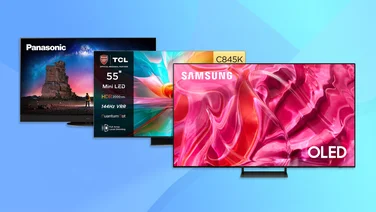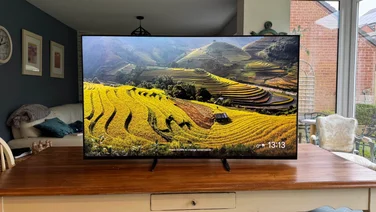To help us provide you with free impartial advice, we may earn a commission if you buy through links on our site. Learn more

The TV in your living room is most probably a Full HD model with around two million pixels and very nice it looks too. However, when you go to the cinema you’re watching films projected with a whopping eight million pixels. Ultra HD Blu-ray is a new standard for movies on discs which will bring cinema-quality films into your home. And the difference in visual quality is startling.
This guide will discuss what you need to watch these new high-detail movies in terms of kit and what TVs and players are available today. We’ll also look at the various movies and discs that are set for release at launch. And finally, we’ll discuss in some more technical detail the differences between the current Blu-ray format and the new Ultra HD one.
4K or Ultra HD – confused?
4K and Ultra HD are often used interchangeably, which can be confusing, so let’s nip this one in the bud first. 4K is the current standard for digital cinema projection, the vast majority of films in the UK are now shown in this format. When you go to the cinema you’re watching a film with a 4K resolution of 4,096×2,160 pixels.
Ultra HD is the consumer standard for TVs. This has a slightly different resolution of 3,840×2,160 pixels because this is exactly four times that of the current Full HD standard (1,920×1,080). Many manufacturers refer to their TVs as being 4K when in reality they all have this slightly lower resolution.
With so many pixels the difference between 4K and Ultra HD is negligible in terms of detail. However, 4K has a slightly more widescreen aspect ratio at 1.9:1, rather than Ultra HD’s 16:9. This means that 4K movies transferred to Ultra HD will have to use slender black bars at top and bottom, or have the edges of the screen sliced off; the choice will be made on a film-by-film basis by the production studio.
With this exception, the two terms are practically interchangeable and manufacturers of kit and discs are generally using both. The new discs are officially called Ultra HD Blu-ray, but they all have ‘4K’ written on them too, just in case you’re more familiar with that term.

What do I need?
To watch Ultra HD Blu-rays in your home, you’ll need three things: An Ultra HD TV, an Ultra HD Blu-ray player and an Ultra HD Blu-ray movie to play on it.
4K/Ultra-HD TVs were laughably expensive at the beginning of last year but have since plummeted in price, leaving anyone who bought in early looking pretty sick. You can buy such a TV from as little as £400 today, and so it’s well worth paying the extra over a Full HD set.
Check that your chosen TV has both HDMI 2.0 and HDCP 2.2 in order to work with the Ultra HD Blu-ray standard, most sets have this but if you see a bargain then look closely at the specs before buying. Our current favourite TVs are listed in our Best TVs article.

No standard Blu-ray player or games console can play the new Ultra HD Blu-ray standard. So you’ll need a new player in order to play the new discs, plus of course, you’ll need some Ultra HD Blu-ray movies to play on it.
Which Ultra HD 4K Blu-ray players are available?
Ultra HD 4K Blu-ray players are available in the UK and we’ve seen a few models. Samsung’s player is one of the cheapest, read our full Samsung Ultra HD Blu-ray Player UBD-K8500 review now for full details. It’s selling for around £240 at present and has everything that most people need, plus a slick design with a curved front edge (to complement Samsung’s own curved TVs of course).
Panasonic also has a player available now, read our Panasonic Ultra HD Blu-ray player DMP-UB900 review for all the details. At around £440 it costs quite a chunk more than the Samsung model but comes with analogue surround sound outputs and high-resolution audio DAC, so plenty for audiophiles to get excited about. When it comes to playing movies, though, it’s essentially the same deal as the Samsung.
Philips also has its own player, the Philips Premium Compact Design 4K Ultra HD Blu-ray player BDP7501. This breaks away from the usual Hi-Fi component format for something that’s only as big as it needs to be, a change we applaud but which might not sit well with those who like their AV racks of same-sized kit. The player costs only $229 (~£180), but can only be found in the US – there is yet to be a UK announcement since its availability in May 2016.
Technically speaking all the players here essentially do the same job, they play Ultra HD Blu-ray discs. They all support HDR (high-dynamic range) for better colour depth and contrast and will all support streaming 4K services such as Netflix.
Streaming has taken off in the last couple of years, whereby some are opting to stream 4K content from their PCs – the Amazon Fire TV at £75 offers a cheap, but yet reliable device to stream content to your TV. This cheaper alternative doesn’t offer a dedicated 4K Ultra HD Blue-ray player, but provide you with a way of viewing 4K content on the big screen.

What Ultra HD 4K movies can I watch?
With many recent films being shot in 4K and many more already mastered into the format for showing in digital cinemas, transferring them to Ultra HD Blu-ray will be a doddle compared to the trials and tribulations of moving celluloid movies to the original Blu-ray format upon its release. That means you can expect to see lots of Ultra HD Blu-ray movies from of the off and quality really shouldn’t be an issue with the format. So what can you watch?
With Ultra HD Blu-ray players and movies dropping in price, their availability has sky rocketed. Warner Bros, 20th Century Fox and Sony have already released many UHD Blu-ray films, such as: Fury Road, The Lego Movie, Fantastic Four, X-Men: Days of Future Past, The Amazing Spider-man 2, and Hancock, among many more. There are no shortages of films available and the list will only continue to grow in strength.

The new boxes are clearly marked with 4K and Ultra HD
How much will discs cost?
Ultra HD Blu-ray discs are more expensive than regular Blu-ray and even more expensive than DVDs. Prices vary a lot at present, depending on the publisher and the retailer, so it’s really good to shop around and find the best price. Some titles are shipping with a regular Blu-ray copy and a digital edition as well, so you can watch them where you want.
It’s no uncommon for new formats to be a lot more expensive than the old ones: Blu-rays were a lot more expensive than DVDs when they launched, although the price difference is much closer now. In the case of Ultra HD Blu-ray, the price increase is likely to be because few people will have the ability to watch Ultra HD discs, so there’ll be a smaller publication run reducing any economies of scale. If Ultra HD Blu-ray really takes off, the cost of the discs is likely to drop rapidly, while multi-buy deals in most shops should help reduce the cost further.
We’ve added some live price links for popular titles below so you can get an idea of present pricing (and help support the site by clicking through).
Can I buy discs overseas?
Ultra HD Blu-ray discs are region free, with no geographic locking system currently used. The Blu-ray association wants to promote more UHD films across the globe, and by having them region-unlocked, it promotes their growth. However, you should always remember that other non-UHD Blu-ray films might be region locked, and so could your Blu-ray player – so it’s always best to buy locally if you can. You can find a selection of films on Amazon USA – among many other international retailers.
In April 2015, leaked documents from Sony detailed how UHD Blu-ray disks would require an internet connection to be played – we’ve yet to hear more about it since then, but it does sound alarm bells for consumers.



![Mad Max: Fury Road [4K Ultra-HD] [2015] [Blu-ray] [Region Free]](https://m.media-amazon.com/images/I/61ErsRN+dqL._SL160_.jpg)
![The LEGO® Movie [4K Ultra-HD] [2014] [Blu-ray] [Region A & B & C]](https://m.media-amazon.com/images/I/61V8aMF8TIL._SL160_.jpg)






